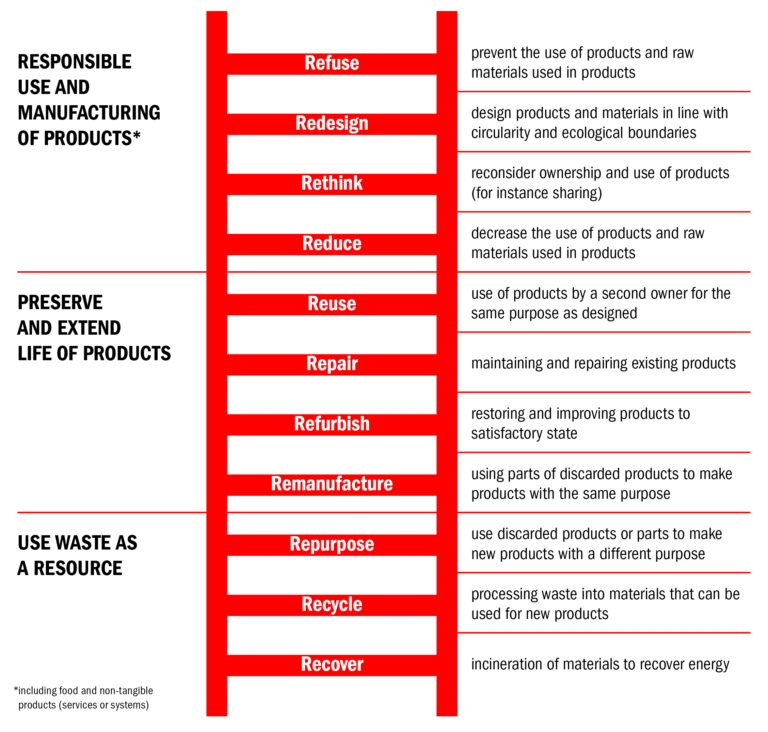5 ways to embed circularity into your creative startup

1. CHECK THE 'R-LADDER'
When it comes to closing the loop, one of the most common mistakes that people make is to equate circularity with recycling. This is why Manon’s first tip is to consider what other approaches may be more impactful. ‘Recycling materials isn’t necessarily a sustainable solution,’ she says. ‘Recycling can be very energy intensive, while reuse can be more effective. Often, materials are also reused in a way that doesn’t make them recyclable again.’
To avoid doing more harm than good, Manon advises designers to use the ‘R-ladder’ as a reference. This diagram can be used to rank and prioritise strategies towards a circular economy. Generally, strategies higher up on the ladder (such as those for rethink, reuse and repair) require fewer resources, and therefore are more sustainable in the long run. While working on your solution, check it often, check it early—and as Manon says: ‘Strive for the ‘highest R’ on the ladder.’

2. MAP YOUR VALUE CHAIN
Next, it’s time to add some systems thinking into the mix, and get to know the ins and outs of the value chain that you are active in. ‘It’s nearly impossible for a company to be circular on its own, like an island,’ Manon points out. ‘You need to collaborate with others in the value chain, for the materials, for the distribution or capture, for finance, for navigating regulations, etc.’ Involving all these stakeholders right from the start will allow you to recognise more opportunities and maximise your impact. It will also help to accelerate change for others in your industry.
‘It’s nearly impossible for a company to be circular on its own, like an island.
You need to collaborate with others.
3. CONSIDER OWNERSHIP
This is another aspect of circular business that is sometimes overlooked. Manon explains: ‘Ownership here doesn’t only refer to the IP, or the ownership of a company, but also the ownership of materials and products. For example, if you use waste streams coming from companies or households; who owns this waste material? Can you always have access to these waste streams, also in the future? What are the regulations about using them?’ The answers to these questions are essential in making sure your solution is not only scalable but also resilient.
Of course, ownership is also interesting to explore as a tenet of the sharing economy. Here, Manon wants to remind innovators that access is not just a design issue, but also a financial and legal one. ‘If you choose a lease model for your circular business, for example, this has effects on your balance sheet, since you will remain the owner of the products. This can also have legal implications, for example for safety or maintenance.’
4. PICK THE RIGHT BUSINESS MODEL
Once you have your circular product or service designed, it’s important to think about the business model you will test and implement. Remember that in a circular economy, growth is linked to the creation of value, and not the consumption of resources. Manon suggests asking questions like: ‘How will you generate revenues? Who are your customers? Who benefits from your solution (for example by avoiding costs of waste disposal)? How will you recover the product or materials you use?’
Here are five business models for a circular economy (from OECD 2018) to help you get started:
- Circular supply models replace traditional material inputs derived from virgin resources with bio-based, renewable, or recovered materials, reducing demand for virgin resource extraction in the long run.
- Resource recovery models recycle waste into secondary raw materials, thereby diverting waste from final disposal while also displacing the extraction and processing of virgin natural resources.
- Product life extension models extend the use period of existing products, slow the flow of constituent materials through the economy, and reduce the rate of resource extraction and waste generation.
- Sharing models facilitate the sharing of under-utilised products, and can therefore reduce demand for new products and their embedded raw materials.
- Product service system models, where services rather than products are marketed, improve incentives for green product design and more efficient product use, thereby promoting a more sparing use of natural resources.
5. DON’T REINVENT THE WHEEL.
The final tip from Manon is a reminder to leave your ego at the door. The circular economy will not be built by one, but by many. ‘You may have a great idea, a wonderful design, an entrepreneurial solution—but don’t forget to look around for information from the sector and other businesses. Successful or failed, you can learn from both.’ Supportive ecosystems like Impact Hub the Netherlands can offer you a treasure trove of resources, and all the help you need to make your startup investment-ready. Manon notes that their first accelerator programme on the topic of circularity took place nearly a decade ago, in 2013. ‘Some great examples of companies we have worked with in the past are Closing the Loop, MudJeans, FairPhone and Sustainer Homes. I think they are leaders in their sectors and show what is possible.’ Other useful sources from across the globe include the Ellen MacArthur Foundation, Metabolic, Circle Economy, ACEN, PACE, and Groene Brein. In places like these, you can find sector reports, you can find local circular business networks or examples of similar businesses. ‘This way you can leap forward, and not reinvent the wheel,’ says Manon.
‘Don’t forget to look around for information from the sector and other businesses. Successful or failed, you can learn from both.’